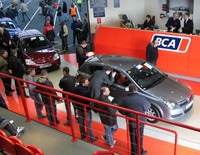Fleet values fall in November
 Interim data from BCA’s Pulse report shows average monthly fleet & lease values reached an 11-month low in November. Values fell to £6,714 in November, the lowest average monthly value recorded since December 2006. Performance against CAP Clean also fell to its lowest point this year at 94.2% - and in fact is the lowest figure recorded since January 2006.
Interim data from BCA’s Pulse report shows average monthly fleet & lease values reached an 11-month low in November. Values fell to £6,714 in November, the lowest average monthly value recorded since December 2006. Performance against CAP Clean also fell to its lowest point this year at 94.2% - and in fact is the lowest figure recorded since January 2006.Fleet and lease values have now fallen for two months running and are £293 down on last month and a significant £631 behind where they were in September. Average values have fallen by 8.6% since September. Despite this, November’s year-on-year values are ahead of those recorded in 2006 by £190 (2.9%).
BCA’s Communications Director Tony Gannon commented “These latest figures will surprise no-one who has been selling used cars in the wholesale market over the past few weeks. The market has got significantly harder and while values soared to new record levels in September we warned then about an underlying softness in demand.”
He continued “Fleet values stalled in October as increasing volumes hit the market from fleet operators and leasing companies. There were growing signs of a two-tier market as well-specified, retail-quality cars found a ready audience of buyers, but average stock in average condition was more difficult to sell, and needed to be competitively priced. November delivered more of the same, and has simply underlined that weaker market. The performance against CAP suggests there is some pragmatism among fleet & lease sellers and an understanding that the best bid may be well short of CAP Clean.”
He added “In 2006 we experienced a shortage of stock, which continued into the first three quarters of 2007. But the current market in Quarter 4 is very different. Taking this into consideration, values remain ahead of where they were last year.”
Part-exchange business has remained steady over the past three months, even as volumes increased late in September onwards. A good balance between supply and demand meant prices were firm and BCA’s Pulse data showed average part-exchange values increased to record levels in October at £3,351, falling back to £3,220 in November. Performance against CAP Clean slipped below 90% in November.
Gannon concluded “As always, professional buyers want to buy the most attractive, best specified vehicles in the right colours at a sensible mileage, because those vehicles are the ones that will attract retail buyers on the forecourt. As market conditions tighten, condition gets even more important. With increasing pressure on businesses to focus on their core activities, dealers want to spend their time selling cars to motorists, not repairing them in their bodyshops.”

